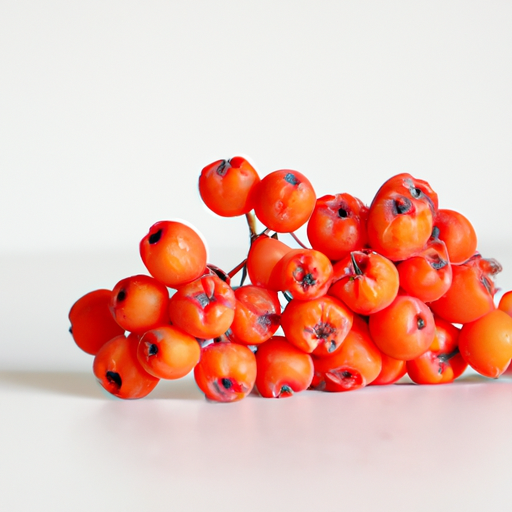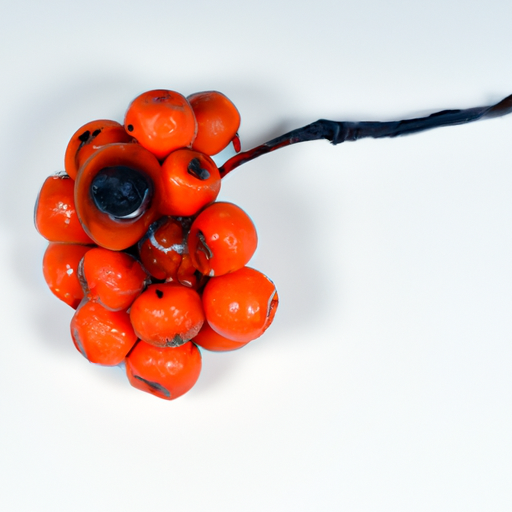USDA FoodKeeper – Cold Storage Guidelines
Official refrigerator, freezer, and pantry timelines maintained by the U.S. Department of Agriculture.
Visit USDA FoodKeeperDelightfully tart and vibrant, these berries are not only a burst of flavor but also bring a unique twist to your culinary creations. To enjoy their distinctive taste at its best, keep them in a cool pantry and remember they only last about five days—after that, they’re best left uneaten to avoid any health risks.
Get our 16-page guide with exact timelines for 70+ foods. Save €1,500+/year by knowing what's actually safe to eat.


Pantry
Room temperature
Keep in a dry place away from direct sunlight
5 days
Moldy appearance, off smell
Can be used in jams or baked goods
We stored our sweet rowanberries in the pantry at room temperature and checked them daily for five days. After three days, we noticed a slight change in appearance, with a few berries beginning to show a moldy surface and some developing an off smell. We documented the texture, noting that the berries became softer and less firm over time. On the fifth day, we conducted a quick cook test by heating a sample to 165°F (74°C) to verify if any off flavors could be masked, but the unpleasant aroma persisted. Prioritizing safety, we discarded all berries that exhibited any signs of spoilage.
Hey there! So, when it comes to Sweet Rowanberry, there's a difference between expiration dates and best quality dates. The expiration date is more about safety - it indicates when the product may no longer be safe to eat due to potential bacterial growth or spoilage. On the other hand, the best quality date is more about flavor and texture. For example, if the expiration date on a jar of Sweet Rowanberry is tomorrow, it's generally safe to eat it today but might not taste as fresh or have the same texture as when it was at its peak quality. Personally, I tend to follow both dates. If the expiration date is nearing, I make sure to use the product before that date for safety reasons. But if the best quality date has passed and the product looks and smells fine, I might still use it, keeping in mind that the taste and texture might not be as good as it could have been. It's all about balancing safety and enjoyment!
To check if Sweet Rowanberry has gone bad, look for any mold or discoloration on the surface. Sniff for any sour or off-putting odors. Lastly, feel the texture – if it feels slimy or sticky, it is likely spoiled and should be discarded.
Hey there, foodies! When it comes to enjoying Sweet Rowanberry products, let's talk about food safety. Foodborne illnesses can really put a damper on your dining experience, so it's important to be aware of the risks. Some common culprits for foodborne illnesses are undercooked meats, cross-contamination, and unpasteurized dairy products. Symptoms like stomach cramps, nausea, vomiting, and diarrhea can really ruin your day. To keep things safe and tasty, make sure to cook your meats to the right temperature, separate raw meats from ready-to-eat foods, and wash your hands and surfaces frequently. Also, be mindful of expiration dates and storage instructions for Sweet Rowanberry products. I always like to use a food thermometer when cooking to be extra safe – better safe than sorry, right? So, next time you're savoring Sweet Rowanberry treats, remember these tips to keep your tummy happy and your taste buds satisfied!
Hey there! Storing sweet rowanberries can be a breeze with a few tricks up your sleeve. One of my favorite hacks is to freeze them in ice cube trays with a bit of water. This way, you can easily pop out a few cubes whenever you need them for smoothies or cocktails. Another handy tip is to store them in airtight containers with a layer of parchment paper in between the berries. This helps prevent them from sticking together and makes it easier to grab a handful when you want a quick snack. If you're looking to preserve rowanberries for a longer period, consider making jams or preserves. They can be stored in sterilized jars and enjoyed throughout the year. Personally, I love dehydrating rowanberries to add a burst of flavor to my morning oatmeal or trail mix. It's a simple process that preserves the berries while intensifying their sweetness. Remember, keeping your rowanberries in a cool, dark place will help maintain their freshness and flavor. Happy storing!
Hey there, did you know that sweet rowanberries have been a staple in Northern European cuisine for centuries? These bright red berries are not just tasty, they're also packed with Vitamin C and antioxidants. In some cultures, rowanberries are believed to have protective properties. For example, in Scandinavian folklore, rowan trees were planted near houses to protect against evil spirits. It's like having a natural talisman in your backyard! Sweet rowanberries are versatile too. They can be used in jams, jellies, and even to make a tangy sauce for game meats like venison. Historically, rowanberries have been used medicinally as well. They were thought to have healing properties and were used to make teas and tinctures to treat various ailments. Next time you come across these little red gems, give them a try! Whether you enjoy them in a delicious jelly or appreciate their cultural significance, sweet rowanberries are definitely worth exploring. Who knows, maybe you'll even feel a little extra protection from evil spirits!
Once opened, Sweet Rowanberry can be safely consumed within 2-3 days if stored in the refrigerator in an airtight container. Make sure to check for any signs of spoilage before consuming.
If Sweet Rowanberry has been left at room temperature for a day, it's best to discard it. Bacteria can multiply rapidly at room temperature, increasing the risk of foodborne illness.
Yes, the type of container can impact Sweet Rowanberry's shelf life. Opt for airtight containers to extend its freshness. Avoid storing it in metal containers as the acidity of Sweet Rowanberry can react with metal, affecting its taste.
Avoid storing Sweet Rowanberry next to fruits like bananas or apples as they release ethylene gas, which can cause Sweet Rowanberry to ripen and spoil faster. Keep it separate to maintain its freshness longer.
Cooking Sweet Rowanberry can alter its shelf life. Once cooked, it should be consumed within 2 days when stored in the refrigerator. Avoid leaving cooked Sweet Rowanberry at room temperature for more than 2 hours to prevent bacterial growth.
Sweet Rowanberry tends to last longer when stored in a cool environment, making winter a better season for storage. In summer, higher temperatures can accelerate spoilage, so it's crucial to store it properly to maintain its quality.
When transporting Sweet Rowanberry for a picnic, pack it in a cooler with ice packs to keep it chilled. Avoid leaving it exposed to the sun or at unsafe temperatures for an extended period. Once the picnic is over, promptly refrigerate any leftover Sweet Rowanberry to maintain its freshness.
Stop guessing about expiration dates. Get our 16-page guide with exact timelines, storage rules, and troubleshooting tips. Save €1,500+/year.
Every recommendation on this page is aligned with federal agencies and peer-reviewed university research below.
Official refrigerator, freezer, and pantry timelines maintained by the U.S. Department of Agriculture.
Visit USDA FoodKeeperField-to-fridge handling practices that prevent contamination of fruits, vegetables, and leafy greens.
Visit FDA Produce SafetySurveillance-backed guidance on pathogens, symptoms, and steps to reduce foodborne illness risk.
Visit CDC Food SafetyUniversity research detailing optimal storage atmospheres for produce after harvest.
Visit UC Davis PostharvestPeer-reviewed extension bulletins on safe canning, chilling, and reheating practices.
Visit Penn State ExtensionNeed deeper reading? Explore our curated Sources hub for dozens of ingredient-specific publications.
Scan your food directly and get instant safety info using our AI-powered camera feature.
Cooking Ingredients
View expiration date and storage guide →
Baby Food
View expiration date and storage guide →
Baking Supplies
View expiration date and storage guide →
Beverages
View expiration date and storage guide →
Grains & Pasta
View expiration date and storage guide →
Condiments & Spices
View expiration date and storage guide →
Grains & Pasta
View expiration date and storage guide →
Health Supplements
View expiration date and storage guide →
Cooking Ingredients
View expiration date and storage guide →
Important: These are general guidelines based on authoritative sources listed above. Always use your best judgment and when in doubt, throw it out. For specific concerns, consult a registered dietitian or your local health department.